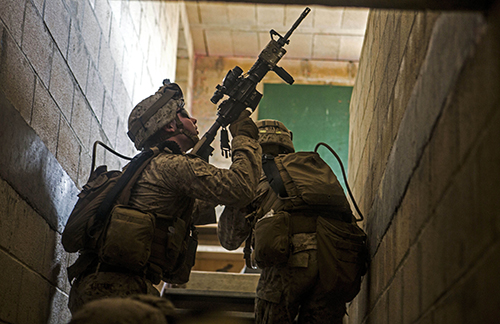Divisions
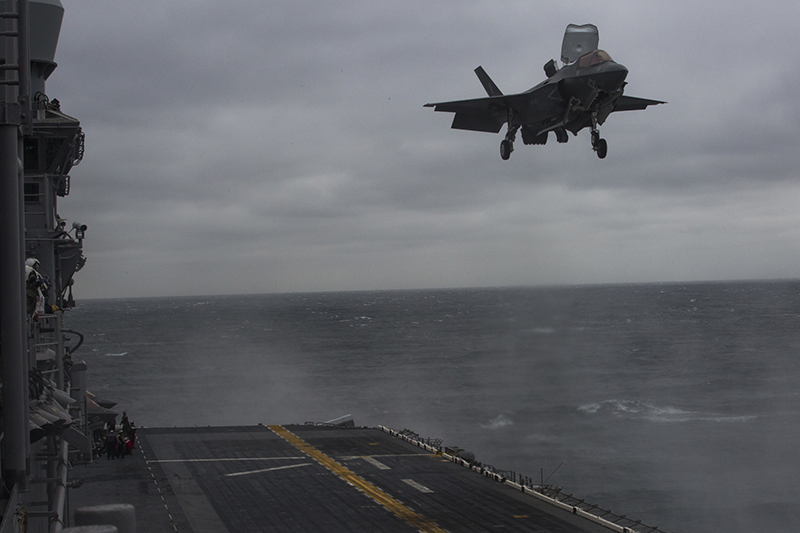
An F-35B Lighitng II performs deck landing qualifications on the USS Wasp (LHD-1), March 5, 2018. Marine Fighter Attack Squadron 121 embarked a detachment of F-35Bs on the USS Wasp for the 31st Marine Expeditionary Unit’s Spring Patrol 2018, marking the first operational deployment of the F-35B with a MEU. As the Marine Corps' only continuously forward-deployed MEU, the 31st MEU provides a flexible force ready to perform a wide range of military operations. (Photo by Cpl. Bernadette Wildes)
On Thursday, May 24, 2018, the Center for Adaptation and Innovation (CAI) hosted the 31st Marine Expeditionary Unit (MEU) and the WASP Amphibious Ready Group as part of its Returning Commander Speaker Series. The 31st MEU BHR ARG/31st MEU was deployed from 6 June through 12 September 2017, and the WASP ARG/31st MEU was deployed from 19 March through 23 April 2018. Captain Ed Thompson was the Commodore of PHIBRON 11 and Colonel Tye R. Wallace was the commanding officer of the 31st MEU.
The 31st MEU participated in multiple high level exercises. They took part in Sea Dragon 2025, which is the big picture vision for the Marine Corps that focuses on a variety of equipment enhancements as well as command structure changes. The 31st MEU also participated in Talisman Saber ’17 where they participated in combined joint amphibious landings and certification of AUS amphibious ships. The 31st MEU was the inaugural deployment of the first operational F-35B. The F-35B provides the MEU capability to operate in a high threat environment. During Operation Ssang Yong ’18 the MEU established and executed fully operational F-35 capable FARP.
Marines with Special-Purpose Marine Air-Ground Task Force Crisis Response-Africa practice clearing a house during a two-week infantry training package, August 4-15, 2015, aboard Naval Station Rota, Spain.
(U.S. Marine Corps photo by Staff Sgt. Vitaliy Rusavskiy/Released)
On Tuesday, April 10, 2018, the Center for Adaptation and Innovation (CAI) hosted the Special Purpose Marine Air-Ground Task Force—Crisis Response—Africa 18.1 (SPMAGTF-CR-AF) as part of its Returning Commander Speaker Series. The SPMAGTF-CR-AF was deployed from October 2017 through March 2018. Commanding Officer Colonel Michael J. Perez, USMC, alongside members of his staff briefed guests and Potomac Institute staff of the accomplishments and complex missions bestowed upon the SPMAGTF-CR-AF.
The SPMAGTF-CR-AF was comprised of roughly 1,000 Marines and Sailors, and has a unique mission to conduct limited crisis/contingency response operations to safeguard US citizens and interest in the USAFRICOM region as well as theatre security cooperation to enable training and progress the USAFFRICOM theatre campaign plan objectives.
While deployed the SPMAGTF-CR-AF trained in 10 European countries, operated within 9 different African nations while conducting 16 different theatre security cooperation events throughout the course of the deployment. Colonel Perez stressed the importance of intelligence gathering for the SPMAGTF-CR-AF, with such a unique and evolving mission set it was imperative to be tied into up-to-date intelligence for situational awareness. The Colonel also emphasized the value of relationship building with commanders from the host nations both in Europe as well as Africa, and the benefits of those good relationships moving forward, specifically in relation to joint training events for future SPMAGTF-CR-AF rotations.
On Wednesday, January 10, 2018 the Center for Adaptation and Innovation (CAI) hosted the Special Purpose Marine Air Ground Task Force Southern Command (SPMATF-SC) as part of its Returning Commander Speaker Series. The SPMAGTF-SC was deployed from June 2017 to November 2017, and conducted Partner Nation capacity building and engineer projects, as well as crisis response. Commander Officer Colonel Michael V. Samarov, USMC briefed guests and staff of the Potomac Institute, and reminded us of the dedication of the Marine Corps and Navy.
The SPMAGTF-SC is comprised of 300 Marines and Sailors, and is a unique element whose construct is primarily reserve Marines. During deployment, the SPMAGTF-SC conducted operations and capacity building throughout Central America, and operated in Honduras, Belize, Guatemala, and El Salvador. Capacity building helps Partner Nations provide security to their populations, and is integral to the overall SPMAGTF mission. Engineering detachments also worked with partner nations, aiding construction projects in the region.
The SPMAGTF-SC also provides humanitarian assistance, and served as the core of the Joint Task Force - Leeward Islands (JTF-LI), which was tasked with responding to and assisting partner nations following Hurricanes Irma and Maria. The Marines and Sailors of the SPMAGTF-SC supported humanitarian assistance and disaster relief efforts in the Caribbean Sea, and pulled together capabilities in Guatemala and Honduras to have a rapid response capability. An Aviation element was also deployed to San Juan to evacuate people during Hurricane Irma, and Americans on Dominica were evacuated during Hurricane Maria. The humanitarian assistance provided demonstrated the tremendous capability of our reserve components, and that the time spent preparing for crisis response is never wasted.
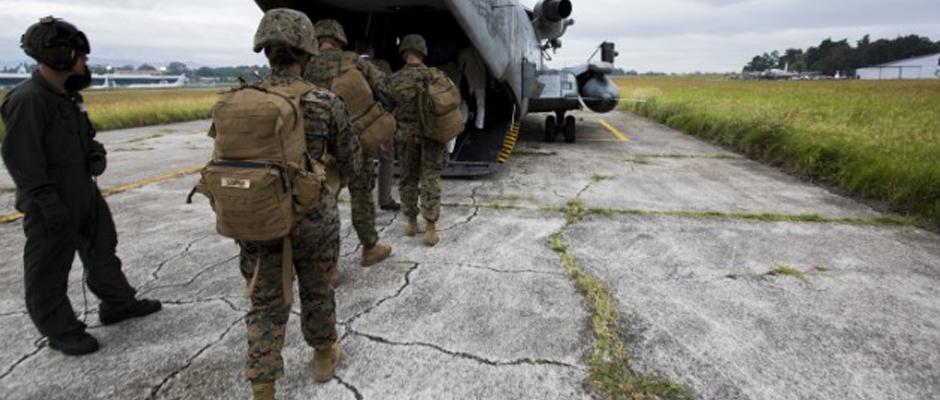
U.S. Marines with the Special Purpose Marine Air-Ground Task Force-Southern Command board a CH-53 Super Stallion in Guatemala City, Guatemala, July 9, 2015(DoD Photo)
http://www.southcom.mil/Focus-Areas/Rapid-Response/
On Tuesday, 13 March 2018, the Center for Adaptation and Innovation (CAI) hosted Colonel J.R. Clearfield, USMC, commander of the 15th Marine Expeditionary Unit (MEU), and Captain Rome Ruiz, USN, commander of Amphibious Squadron THREE and the America Amphibious Ready Group (ARG).
The 15th MEU was deployed from 7 July 2017 to 2 February 2018, conducting operations in Pacific Command, Central Command and Africa Command. During the 211-day deployment the ARG/MEU functioned beyond mutually supporting range for 168 days. The ARG/MEU was split was 19 days, distributed for 44 days and disaggregated for 105 days1.
This was the maiden voyage for the amphibious assault ship USS America (LHA 6), which differs from previous LHA’s due to the fact that the America does not have a well deck. Instead, the America has more room for additional aviation capabilities. Capt. Ruiz described America as “designed to be a command-and-control ship”2.
The MEU totaled 2,500 Marines and over the course of the deployment 2,100 Marines went ashore. At one point the Marines were operating or supporting other Marine units in 21 different countries. While operating in Central Command the Marines participated in exercise Alligator Dagger with regional partners to rehearse potential contingency operations and crisis response. The Marines also participated in exercise Iron Magic, alongside coalition partners in the United Arab Emirates. The Aviation Combat Element of the 15th MEU directly supported the fight against violent extremism in support of Operation Inherent Resolve.
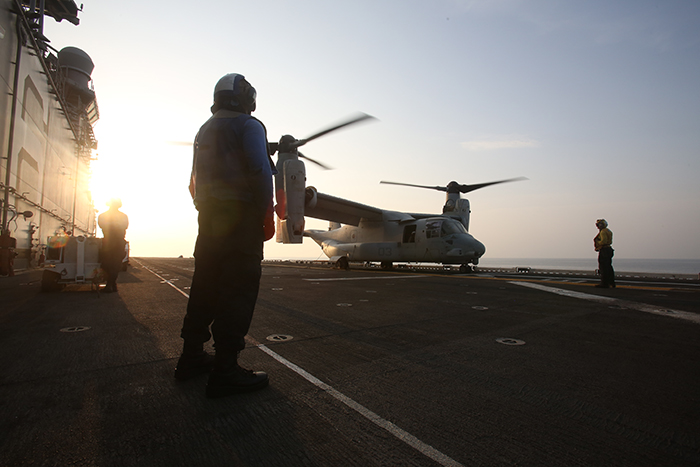
Sailors with the America Amphibious Ready Group prepare an MV-22B Osprey for take off aboard the amphibious assault ship USS America (LHA 6). The Osprey is designed for expeditionary assault support, raid operations, cargo lift and support to special warfare, it is capable of vertical takeoff and landing, and short and takeoff and landing (VSTOL). (U.S. Marine Corps photo by Lance Cpl. Dusty Kilcrease)
1“Split” refers to elements of a MEU/ARG operating separately for short periods of time and/or short distances. The ARG and MEU commanders still maintain command of these units during this time. “Disaggregated,” by contrast, refers to elements of a MEU/ARG operating under different chains of command, regardless of the time-space distance between the elements of the MEU/ARG.
2Burgess, Richard. USS America ARG/MEU: Operations Adjust to Aviation-Centric Amphib. Seapower Magazine. (14 March 2018). Retrieved from: http://seapowermagazine.org/stories/20180313-america.html.
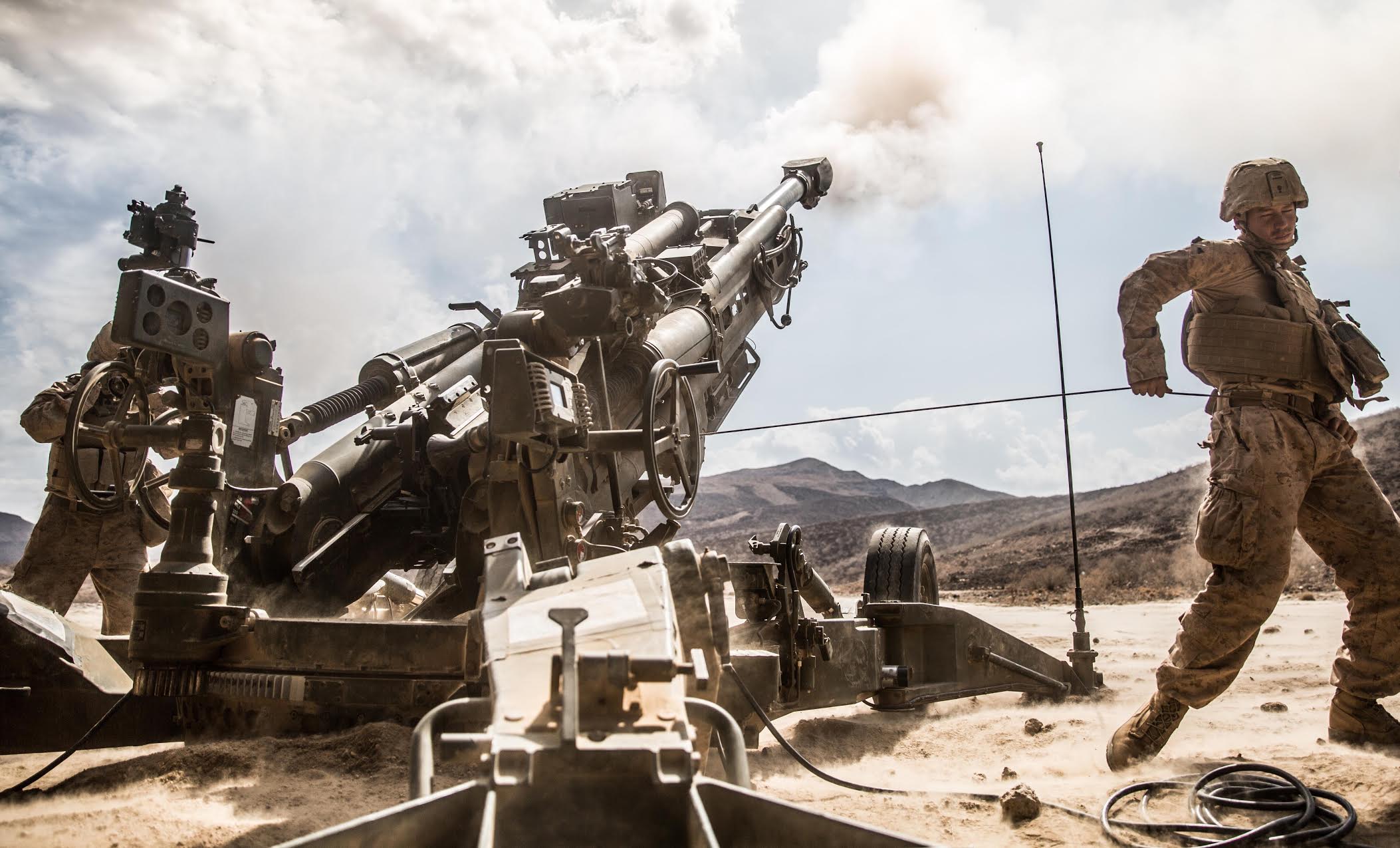
Marines with Alpha Battery, Battalion Landing Team 1st Bn., 4th Marines, fire their M777 Howitzer during Exercise Alligator Dagger, Dec. 18, 2016. US Marine Corps Photo
https://news.usni.org/2017/03/09/report-marines-11th-meu-join-ground-fight-syria
On Friday 28 July 2017, the Center for Adaption and Innovation (CAI) hosted Colonel Clay Tipton, USMC, commander of the 11th Marine Expeditionary Unit (MEU), and Captain Michael Crary, USN, commander of USS Makin Island Amphibious Ready Group (ARG), as part of its Returning Commander Speaker Series.
The 11th MEU/Makin Island ARG deployed from October 2016 to May 2017, and operated in three areas of responsibility: Pacific Command, Central Command, and Africa Command. During the 214-day tour of duty, the MEU/ARG operated in several configurations, including 82 days aggregated, 118 split, and 14 days disaggregated1. According to Colonel Tipton, the MEU trained and operated as an “aggressive, raid-based organization.” Colonel Tipton placed a commanding officer from each of his three major subordinate elements on one of the ARG’s three ships, both to enhance communication and cooperation between the Sailors and Marines, and to facilitate the use of mission-type orders.
Additionally, the Marines and Sailors spent most of their time in the Gulf of Aden, a region where piracy, arms trafficking, and civil war proliferate. Within this region, the MEU/ARG efforts focused on countering violent extremists, as well as threats to maritime trade and sea lines of communications.
A major highlight of the deployment occurred in March 2017, when the MEU supported Operation Inherent Resolve, the effort to defeat ISIS in Iraq and Syria. Battalion Landing Team 1/4, the ground combat element of the MEU, sent a battery of M777 155-mm howitzers into northern Syria to assist in the forthcoming battle for Raqqa, an ISIS stronghold and its de facto capital. The MEU/ARG also conducted extensive training operations, both on its own and, with US allies. This included eight major unilateral and bilateral exercises, as well as a number of smaller advisor and personnel exchanges.
Among the takeaways from the deployment, CAPT Crary remarked that each MEU/ARG needs to be better than the last, “because the enemy gets a vote.” He also stated that, while the Navy/Marine Corps team certainly wants better communication capabilities, “we must be able to function in less-than-perfect comms, [and] less-than-perfect connectivity.”
1“Split” refers to elements of a MEU/ARG operating separately for short periods of time and/or short distances. The ARG and MEU commanders still maintain command of these units during this time. “Disaggregated,” by contrast, refers to elements of a MEU/ARG operating under different chains of command, regardless of the time-space distance between the elements of the MEU/ARG.

